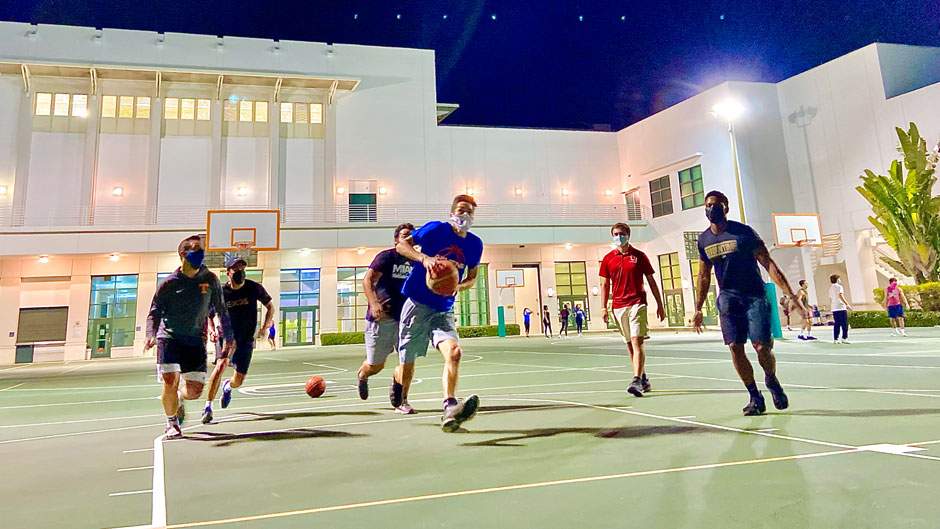When you step on the outdoor courts next to the Herbert Wellness Center or the intramural fields near Stanford Residential College, you will notice that some things look different than they did a year ago—students dribbling up and down the court in masks, circles painted strategically six feet a part in the grass, and cannisters of disinfectant wipes around every corner.
Although “normal” sport playing is widely missed, there has been no shortage of creativity coming from the staff and students of the University of Miami’s intramural sports program. From new sports like human foosball and soccer tennis to virtual games like trivia and Madden, managers have gotten creative to provide fun and safe ways to keep students active and involved.
When the gravity of the coronavirus set in last spring, it was particularly daunting for Zachary Bemmel, the coordinator of recreational sports in the Department of Wellness and Recreation. Bemmel, who plans and oversees all intramural activities, had to come up with ways to adapt and redesign activities almost completely reliant on the physical participation of students.
But Bemmel wasn’t alone in this challenge—he turned to fellow staff members from near and far. He found inspiration from the National Intramural and Recreational Sports Association. During the past year, Bemmel said he has attended numerous webinars, conference calls, and even communicated via message boards to exchange ideas and information with other sports programs across the country.
“It’s national, but it’s a tight-knit community,” said Bemmel. “We communicate amongst each other a lot, especially now with everything going on.”
In fact, that’s exactly how Bemmel discovered one unique sport that ended up a part of the intramural schedule for the first time this semester—human foosball. Usually played with an inflatable pen and ropes, Bemmel adapted it to meet COVID-19 guidelines by eliminating the rope and instead using personal boxes painted on the grass. “Think of it as socially distanced soccer,” he said.
Along with human foosball, which wrapped up its three-week season in mid-March, are sports like corn hole, soccer tennis (think the rules and court of tennis played with feet and a soccer ball), and homerun derby (a competition to see who can hit a softball the furthest). The student leaders of intramurals, nicknamed “red shirts” for their recognizable uniforms, have also played a major role in ensuring sports play on during the pandemic.
Ben Ezzy, a graduate student studying interactive media, is one of 11 red shirts. It’s his fourth year as an intramural supervisor and fifth year working at the Herbert Wellness Center, where he started as a referee during freshman year of his undergraduate studies.
The biggest challenge, according to Ezzy, has been marketing events and getting students to sign up. “Coming up with activities that you can do with social distancing that are still fun and exciting has been a challenge, but the response we’ve gotten from our participants has been positive,” he said. “We know students want ‘real’ sports and team-based activities, so we’ve tried to design activities that are fun and engaging for them.”
Ezzy came up with the Team Relay Challenge, where individuals complete a series of challenges as part of a team in a different sport each week. This week, for example, it was basketball—the students had to do two consecutive free throws, dribble down and back up the court twice, score eight layups, dribble the basketball 50 times, score 25 points without attempting the same shot twice, and score a three-pointer.
“I wanted to find a way to bring back the team aspect of intramural sports, along with some of the activities that participants are missing, like basketball and soccer,” Ezzy said. “I watch ‘Survivor’ and I figured a fun way to do that would be to create our version of immunity challenges with sports-based obstacles.”
Other than bringing a new approach to sports, the need for contactless formats during the pandemic has expanded another aspect of intramurals—virtual games. “The biggest positive is that it [the pandemic] finally gave us the push to do more E-sports,” Bemmel said. “Now we’ve seen how successful they have been here and at other schools.”
UM Intramurals has held tournaments for popular video games like Madden NFL, NBA 2K, and FIFA along with hosting channels on Discord, a platform for online communication. “We wanted to build a community for UM students in general, even if you aren’t a gamer. You can talk academics, posts memes, music, your pets. It’s just to gather in one place and meet other people,” Bemmel added.
The group also has started a biweekly trivia game (played via Zoom using the quiz game Kahoot), a virtual trick shot competition where students send in homemade videos of their wackiest skills, and a virtual 5K run where participants recorded their run done anywhere within a two-week window and submitted their time. “It was fun to see a lot of people sign up for that last semester,” Bemmel said about the virtual 5K. “It was people that typically wouldn’t sign up for any intramural sport.”
Bemmel and his staff are in the process of planning next fall’s sports schedule. While he said they are hoping the public health situation will allow them to bring back their most popular sports like flag football and basketball, they are scheduling with current guidelines in mind.
For more information including sport schedules and updates on events, visit the intramural website and follow @umintramurals on Instagram.

